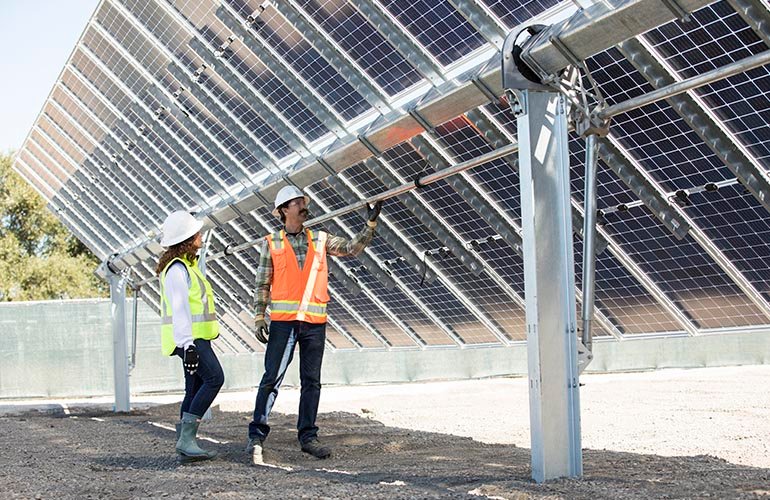—Single-axis trackers
By Billy Ludt
Manufacturers are constantly making incremental improvements to their solar panels to create a higher energy yield per unit than previous and competing models. Another proven way to increase system output is by using solar trackers, which, unlike fixed-tilt ground-mount systems, make solar panels follow the sun’s path throughout the day.
There are two main types of solar trackers available on the market: single- and dual-axis.
Single-axis solar trackers track the sun east to west, rotating on a single point, moving either in unison, by panel row, or by section. Dual-axis trackers rotate on both the X and Y axes, making panels track the sun directly.
“Solar trackers make financial sense when the yield gain over fixed-tilt applications outweighs the capital expenditure of the system,” said Alex Au, chief technical officer at NEXTracker. “In the past decade, the cost of solar trackers has come down considerably with [levelized cost of energy] value engineering and overall demand for these systems, given a 15 to 30% production gain over fixed-tilt systems on the same size array.”

Array Technologies trackers use linked-row architecture to power tracking for multiple rows with a single motor. Array Technologies
Tracking technology is not new to the solar market, but single-axis solutions have recently become a standard in utility-scale applications. Berkeley Lab found that 70% of utility-scale solar installed in 2018 used tracking systems.
“I’d say even eight years ago, trackers were either nonexistent in a utility-scale market or were just a small fraction of the share relative to plants being built in the U.S. right now,” said Jeff Krantz, CCO at Array Technologies.
Single-axis trackers will gather less energy per unit compared to dual-axis trackers, but with shorter racking heights, they require less space to install, creating a more concentrated system footprint and an easier model for operations and maintenance.
Single-axis trackers are split into centralized and decentralized tracker types. Centralized or distributed trackers use a single motor to power a driveline between rows that will move an entire segment of panels. Decentralized systems have one motor per tracking row. There are also instances of trackers with motors present on every set of racking, making rows more adjustable during installation and in some cases allowing them to track independently of neighboring modules.
“In recent years, with rapid reduction in global solar module pricing, banks and developers are favoring single-axis tracking systems’ power capacity (number of modules) to achieve PPA targets over other such systems like complicated dual-axis applications that improve efficiency,” Au said.
Single-axis solar trackers were initially designed to work like Venetian blinds with panel rows moving in unison throughout the day. Now, considerations are being built into tracking software to have panel rows compensate for diffuse light, adverse wind conditions and row and horizon shading.
On cloud-covered days, sunlight doesn’t reach the Earth’s surface with direct beams — it is received as diffuse light — which means a panel facing directly at the sun won’t necessarily have the most generation. It could mean panels will stow horizontally to catch the diffuse light.

“In areas where you’ll have a significant amount of cloud cover over the course of the year, there’s some benefit of having the tracker at a flatter angle than actually following exactly where the sun should be,” Krantz said
Similarly, with harsh wind conditions, trackers are programmed to stow panel rows horizontally. Newer models can compensate for higher wind loads, and, in certain cases, system-level monitors can determine which panel rows are unaffected by wind events and allow those rows to continue tracking.
Linked-row single-axis solar trackers historically don’t lend as easily to installation on steep, undulating topographies, where grading might be required. However, certain models can now compensate for uneven landscapes. The technology, which hasn’t had a large presence in colder climates, is starting to venture further into those regions.
“Many colder weather, higher altitude climates are seeing the adoption of solar trackers — and as such, controller technologies and stow strategies have advanced to withstand colder temperatures and snow loads such as NEXTracker,” Au said.
Certain racks and tracking algorithms are designed to account for bifacial panels and their dual-sided solar production. Other single-axis models are designed to fit modules in two-in-portrait orientation.
“It’s a relatively heavy engineering lift,” Krantz said. “Having a metal infrastructure for these millions of panels that can sustain all the different elements that it’s going to experience over the course of that 25 or 30 years and then also to have it be moving because it inherently needs to follow the sun from east to west. There were some naysayers that believed it wouldn’t be feasible in the early stages, but at this point, that’s really not the case for most companies.”







